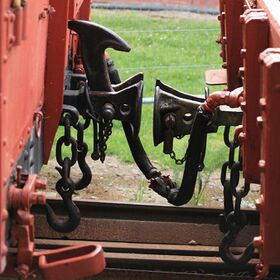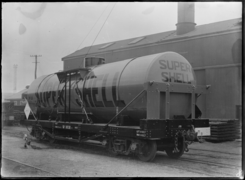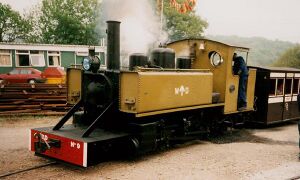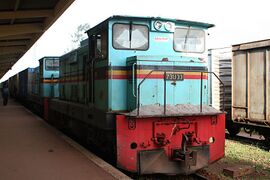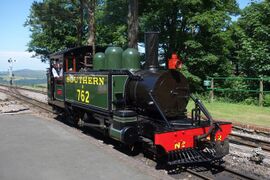Engineering:Norwegian coupling
A Norwegian coupling or coupler (also known colloquially as a chopper coupling or claw hammer coupling), is a manually operated coupling at each end of some narrow-gauge railway rolling stock. It consists of a central buffer incorporating a hook that drops into a slot in the opposing central buffer.[1] The system is only found on narrow gauge railways with a gauge of 1067 mm (3 ft 6 in) or less on which low speeds and train loads allow a simpler system than, for example, knuckle couplers. Norwegian couplings are not particularly strong, and may be supplemented by auxiliary chains. Not all Norwegian couplings are compatible with one another since they vary in height and width. Some may permit a hook from both rail vehicles to be in place; others may be limited to one.
The Norwegian coupling was developed in Norway about 1870, when the main railway network was built to 1067 mm (3 ft 6 in) narrow gauge. During the 20th century, these lines were rebuilt to 1435 mm (4 ft 8 1⁄2 in) standard gauge or closed. Since the rolling stock needed to be replaced, a change was made to buffers and chain couplers. Nowadays they can be seen only at museum railways, such as the Setesdal Line and Urskog–Høland Line.[citation needed]
The New Zealand Government Railways also moved to buffers and chain couplers but during the 1970s, they developed a large, heavy-duty version of the Norwegian coupler. They were first applied to a fleet of diesel-electric locomotives from the United States fitted with knuckle couplers for North Island Main Trunk express freight trains. However, the locomotives were converted to heavy-duty Norwegian couplers to increase their availability for other routes.[citation needed]
In Australia, Norwegian couplers were used on 1067 mm (3 ft 6 in) lines: Queensland Government Railways, Western Australian Government Railways and the Midland Railway, and on the narrow-gauge lines of the South Australian Railways. Vehicles of the latter railway now operate at the Pichi Richi Railway.
On railway lines where rolling stock always points the same way, the mechanical hook may be provided only on one end of each wagon. This was the situation on the Lynton & Barnstaple (L&B), a narrow gauge line in Devon, England, and still applies to railways in New Zealand and on the Isle of Man Railway. Similarly, the hand brake handles may also be on one side of the wagons only. The L&B originally used side chains in conjunction with Norwegian couplers, but these were found to be unnecessary with the slow speeds employed (15–25 km/h or 9–16 mph) and were removed within a year or so of the line opening in 1898. The Isle of Man Railway still couples its side chains in operation today.
Kenyan railways, Uganda Railways, Tanzanian Railways and Mountain Railways of India use the Norwegian coupler. In Indonesia, Staatsspoorwegen (today Indonesian Railway Company) rolling stock used Norwegian couplings for its 1067 mm (3 ft 6 in) rolling stock.
Gallery
See also
- Bell-and-hook coupler
- Draft gear
- Nilgiri Mountain Railway
- Railway coupling by country
References
 |


